How to Solve Basic Inverse Trigonometric Functions (Precalculus - Trigonometry 20)
TLDRThis video offers a concise guide on solving basic inverse trigonometric functions. The presenter emphasizes the concept that inverse functions and their corresponding functions undo each other, making it easier to solve equations involving inverse trigonometry. The video demonstrates step-by-step solutions for several equations, including those with sine, cosine, and tangent inverses. Key strategies highlighted are isolating the inverse trigonometric function and then applying the appropriate trigonometric function to both sides of the equation. The presenter also touches on the use of the unit circle for reference and the simplification process, ensuring that domain considerations are minimal. The video is designed to prepare viewers for more complex problems in trigonometry by first mastering these fundamental inverse function solutions.
Takeaways
- 📌 The main topic is solving basic inverse trigonometric functions.
- 🤔 Importance of understanding that inverse functions undo each other.
- 📈 To solve an equation, isolate the variable; with inverse trig functions, isolate the function containing the variable.
- 🔄 For sine inverse, use sine; for cosine inverse, use cosine; and for tangent inverse, use tangent to undo the inverse.
- 📐 There's minimal domain restriction when working with inverse trig functions, as they naturally fit the required domain.
- 🌟 Example: Isolate 4 sine inverse of x = pi/4, then use sine on both sides to solve, which results in x = √2/2.
- 📊 Another example: 3 times tangent inverse of x = pi, isolate and use tangent on both sides, resulting in x = √3.
- 🌐 For cosine inverse of 2x = 2π/3, isolate 2x and use cosine on both sides, leading to x = -1/4.
- 🔢 When dealing with multiple terms involving the same inverse function, combine them on one side of the equation.
- 🎓 The process simplifies to using the identity that a function and its inverse cancel each other out, leaving the variable isolated.
- 🚀 The video aims to provide a quick and clear method for solving basic inverse trigonometric equations.
Q & A
What is the main topic of the video?
-The main topic of the video is solving basic inverse trigonometric functions.
What is the key concept introduced for solving inverse trig functions?
-The key concept is that an inverse function undoes the original function, and vice versa, which is used to isolate and solve for the variable within an equation.
How do you isolate the inverse trig function in an equation?
-You isolate the inverse trig function by performing operations such as division to get the inverse trig function by itself on one side of the equation.
What function is used to undo sine inverse in an equation?
-The sine function is used to undo sine inverse in an equation.
What is the result of applying sine to both sides of the equation 4 sine inverse of x equals pi/4?
-Applying sine to both sides results in x = sine of pi/4, which simplifies to x = √2/2.
How do you handle the domain when solving inverse trig functions?
-In the context of basic inverse trig functions, the domain is typically not a concern as the variable x will naturally fit into the required domain.
What is the process for solving the equation 3 times tan inverse of x equals pi?
-First, isolate tan inverse of x by dividing both sides by 3. Then, apply the tangent function to both sides of the equation to solve for x.
What is the value of tangent at pi/3?
-The value of tangent at pi/3 is √3.
How do you approach solving an equation with multiple terms containing cosine inverse of x?
-Combine like terms by moving all terms with cosine inverse of x to one side of the equation and then use the cosine function to undo the inverse on both sides.
What is the final step in solving the equation involving cosine inverse of x?
-The final step is to apply the cosine function to both sides of the equation to eliminate the cosine inverse and solve for x.
What is the cosine of pi (or 180 degrees)?
-The cosine of pi is -1.
Why is it said that there's not a lot of domain work to deal with in basic inverse trigonometric function problems?
-It is because the variable x will naturally fit into the domain required for the function being used, so there is no need for additional adjustments or considerations regarding the domain.
Outlines
📚 Understanding Basic Inverse Trigonometric Functions
This paragraph introduces the concept of inverse trigonometric functions and their role in solving mathematical equations. The speaker emphasizes the reciprocal nature of functions and their inverses, explaining that isolating the inverse trig function within an equation is key to solving it. The process involves using the corresponding trigonometric function (sine, cosine, or tangent) to 'undo' the inverse, thereby simplifying the equation. The paragraph provides step-by-step examples, starting with isolating 'sine inverse of x' and then applying sine to both sides to solve for x. The examples continue with tangent and cosine inverse functions, demonstrating the straightforwardness of the process and the lack of complex domain considerations.
🔍 Isolating and Solving for Inverse Trigonometric Functions
The second paragraph delves into solving equations involving inverse trigonometric functions by combining like terms and isolating the variable. It illustrates how to bring terms involving the same inverse trig function to one side of the equation, combine them, and then isolate the variable by using the appropriate trigonometric function. The paragraph demonstrates this with an example involving cosine inverse, showing how to subtract and add terms to consolidate variables on one side. It then uses the cosine function to eliminate the inverse trig function from the equation, solving for x. The summary reinforces the method's simplicity and the direct relationship between functions and their inverses in solving such equations.
Mindmap
Keywords
💡Inverse Trigonometric Functions
💡Isolate the Variable
💡Sine Inverse
💡Cosine Inverse
💡Tangent Inverse
💡Unit Circle
💡Domain
💡Equation Solving
💡Combining Like Terms
💡Trigonometric Identities
💡Contextual Understanding
Highlights
The video discusses the concept of solving basic inverse trigonometric functions.
Inverse functions can undo the operation of their corresponding functions.
To solve equations, isolate the variable first, which may involve factoring.
Isolate the inverse trigonometric function within the equation to apply the appropriate trigonometric function.
For sine inverse, use sine; for cosine inverse, use cosine; for tangent inverse, use tangent.
Domain considerations are not significant in this context as 'x' will naturally fit the required domain.
Example provided: 4 * sin^(-1)(x) = π, where sin^(-1)(x) is isolated and then solved using the sine function.
Sine of sin^(-1)(x) simplifies to x, and sin(π/4) is known to be √2/2.
The solution is verified by plugging the value back into the equation.
Another example: 3 * tan^(-1)(x) = π, where tan^(-1)(x) is isolated and solved using the tangent function.
Tangent of tan^(-1)(x) simplifies to x, and tan(π/3) is √3.
The process is repeated for cosine inverse, with the example 3 * cos^(-1)(2x) = 2π.
Cosine of cos^(-1)(2x) simplifies to 2x, and cos(2π/3) is -1/2.
The final example involves combining like terms with cosine inverse and solving for x.
Combining 4 * cos^(-1)(x) - 2 * cos^(-1)(x) and adding 2π isolates the variable.
Cosine of cos^(-1)(x) simplifies to x, and cos(π) is -1.
The video emphasizes the simplicity of solving inverse trigonometric functions without worrying about domain issues.
The process is summarized as isolating the inverse function and applying the corresponding trigonometric function.
Transcripts
Browse More Related Video
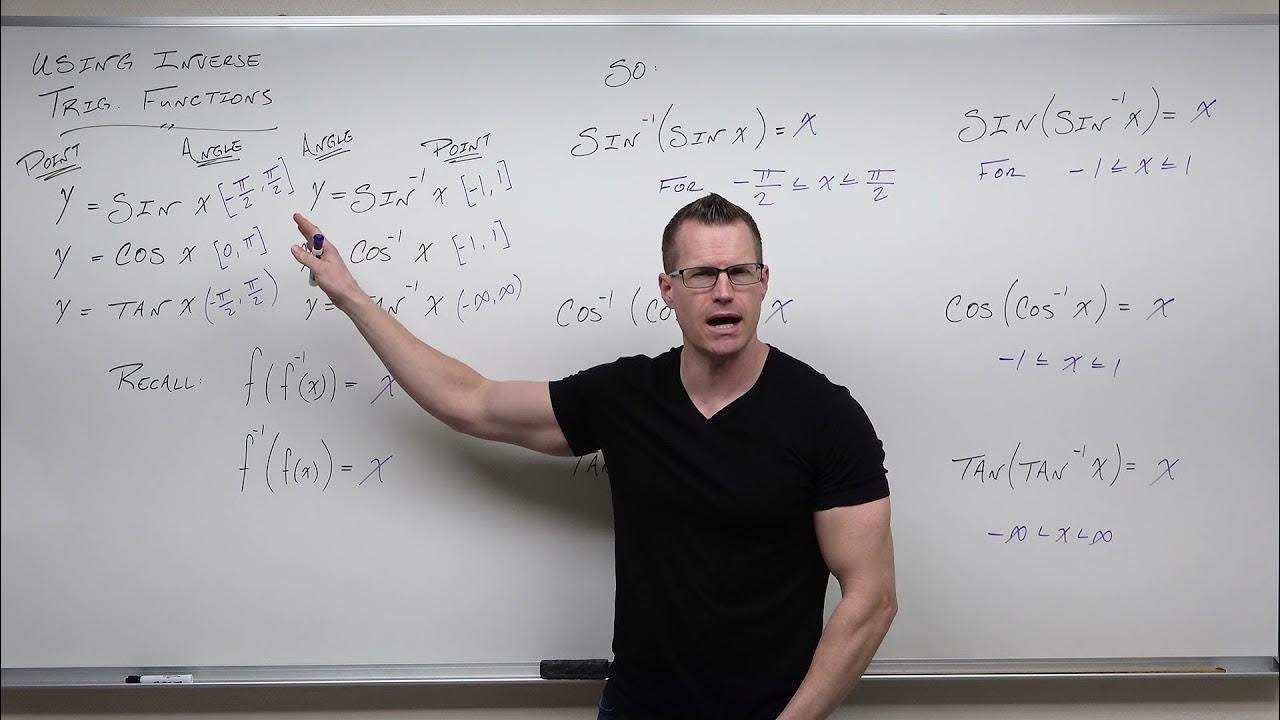
How to Use Inverse Trigonometric Functions (Precalculus - Trigonometry 18)

Inverse Trigonometric Functions
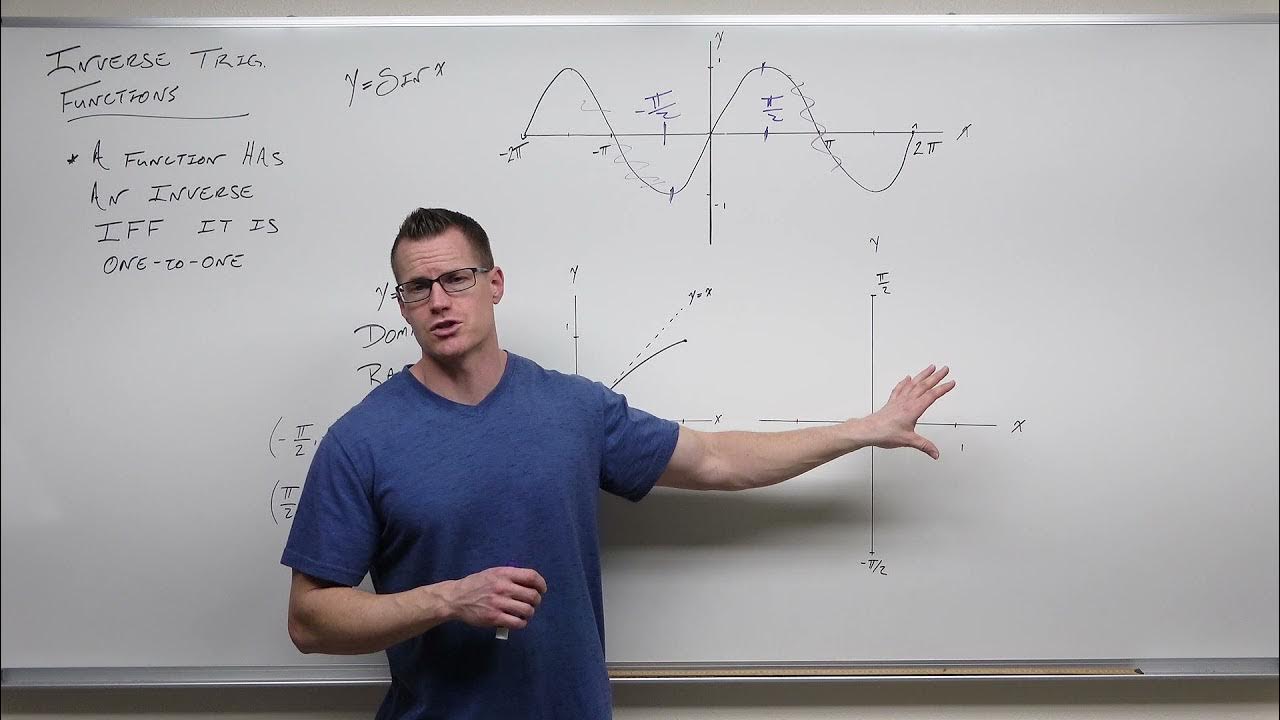
Introduction to Inverse Trigonometric Functions (Precalculus - Trigonometry 17)
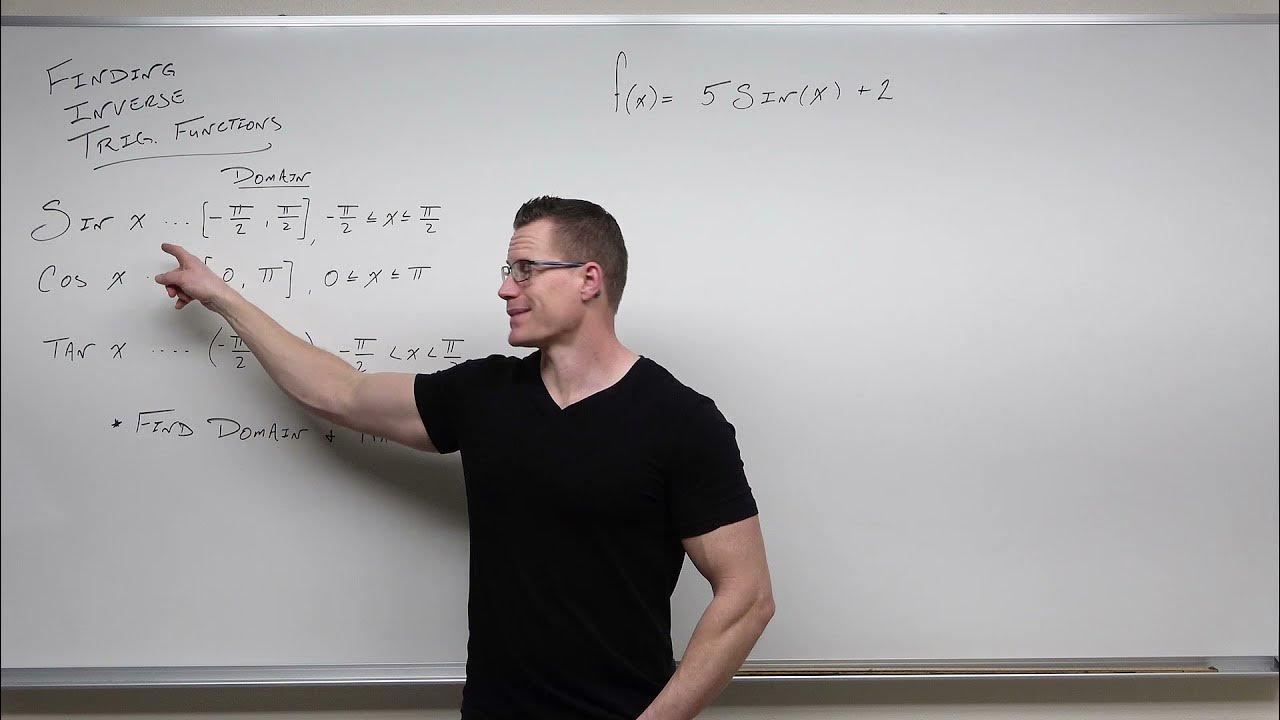
How to Find Inverse Trigonometric Functions (Precalculus - Trigonometry 19)
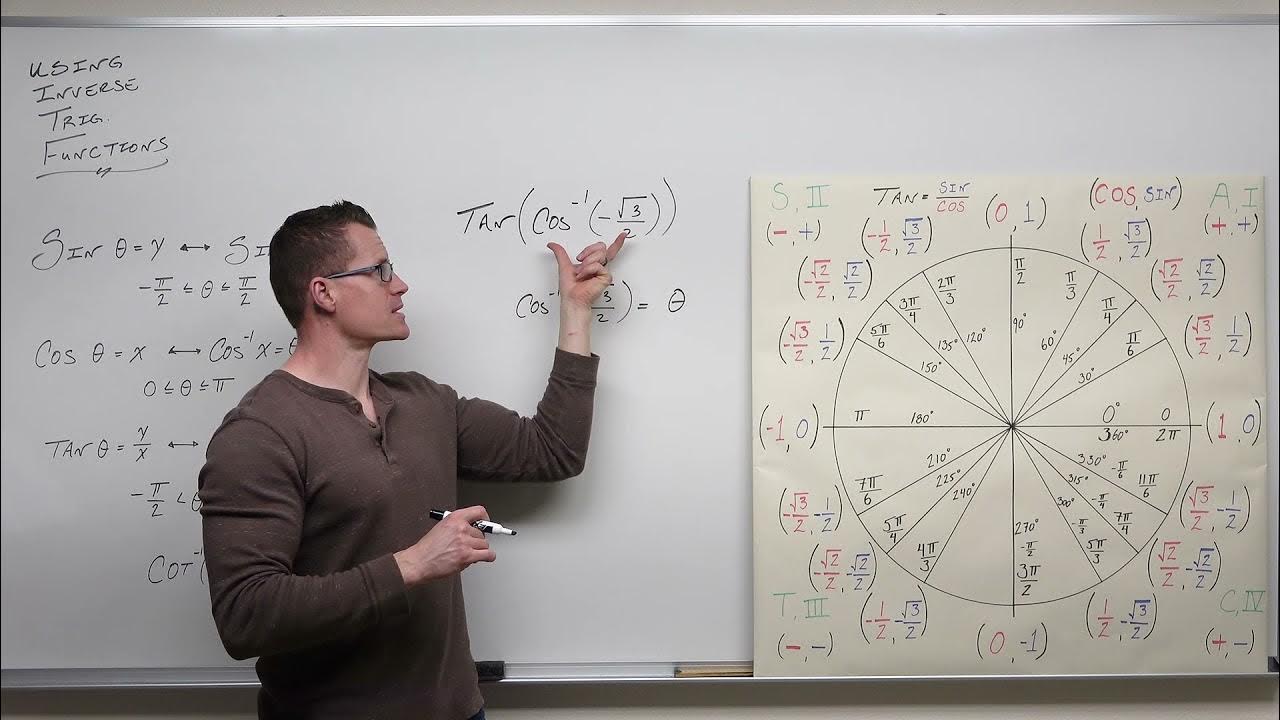
An Indepth Look at Using Inverse Trig Functions (Precalculus - Trigonometry 21)
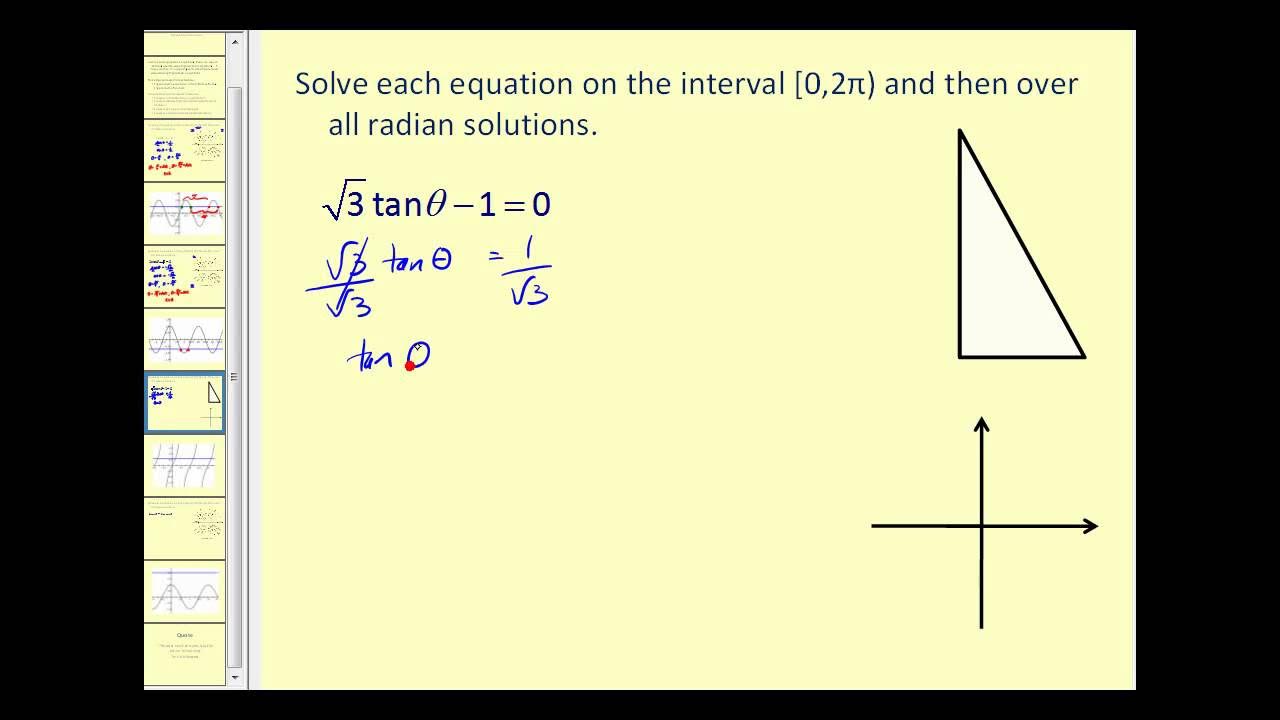
Solving Trigonometric Equations I
5.0 / 5 (0 votes)
Thanks for rating: